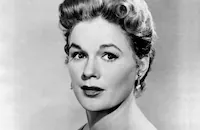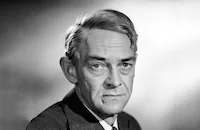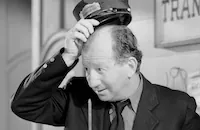Ambush

Brief Synopsis
Cast & Crew
Sam Wood
Robert Taylor
John Hodiak
Arlene Dahl
Don Taylor
Jean Hagen
Film Details
Technical Specs

Synopsis
In 1878, at the foot of Bailey Mountain, Arizona Territory, Ward Kinsman, a prospector and Indian guide, is asked by Major C. E. Breverly of the U.S. Cavalry to help him find Mary Carlyle, the daughter of a general who was abducted during an Indian raid. Fearing a heavy loss of life if he carries out the mission, Ward refuses the Major's request, but later accepts the assignment when Ann Duverall, Mary's attractive sister, asks him to help. Before leaving the cavalry headquarters on a preliminary expedition, Ward punches Tom Conovan, an alcoholic cavalryman who falsely accuses him of being a horse thief. Tom's wife Martha, who has suffered many abuses by her husband, is having an affair with Lt. Linus Delaney. Accompanied by a small group of cavalrymen, Ward follows the trail of Mary's abductors to an Indian encampment. After raiding the camp, Ward learns from an Indian woman that Mary is still alive and is with Diablito's band of Indians, who are directly ahead of them on the trail. While reporting the discovery to Captain Ben Lorrison, Ann's former sweetheart, Ward learns that Breverly has been injured in an attack by Conovan and that Lorrison is now in command. The expedition returns to the fort with an Apache prisoner, Tana, and preparations are made for a full-scale attack on Diablito's caravan. When Lorrison falsely accuses Delaney of causing Conovan's attack on Breverly and orders the lieutenant's transfer, Ward, who dislikes the new commander, challenges him to a fistfight. Though Ward receives a beating from Lorrison, the two eventually put aside their differences and make final preparations for the ambush. On the eve of the ambush, Lorrison proposes to Ann, who later tells Ward that she plans to accept the proposal. Ward balks at the news, and insists that Ann is really in love with him. Soon, after the expedition sets out to find Diablito, Ward kills Tana in self-defense when the Indian double-crosses the squadron and attacks him. The Cavalry squadron eventually finds the Apaches and, after stampeding their horses, engages them in bloody gun battle. As the battle nears its conclusion, Captain Jim R. Wolverson's reinforcements arrive and Ward rescues Mary. Although Ward is satisfied with the outcome of the ambush, Lorrison, determined to effect a complete routing of the Apaches, takes some men with him and goes after a small band of escaping Indians. Ward, realizing that Lorrison and his men are in great danger without a scout, follows them. He arrives too late, however, and discovers that the Indians have killed Lorrison and his men in an ambush. When the expedition returns to the fort, Ann is reunited with her sister and stands at Ward's side as the United States flag is raised to honor the dead.

Director

Sam Wood
Cast

Robert Taylor

John Hodiak

Arlene Dahl

Don Taylor

Jean Hagen
Bruce Cowling

Leon Ames

John Mcintire
Pat Moriarty
Charles Stevens
Chief Thundercloud

Ray Teal
Robin Short
Richard Bailey
Cliff Clark
Lane Chandler
Marta Mitrovich
Flora Nez
Florence Lake
Charles Cane
Ray Bennett
Archie Butler
"doc" George Meyers
Robert Hoy
Carol Henry
Bill Hale
Fred Mcdougal
James Van Horn
Reed Howes
Walter La Rue
Lynn Farr
Phil Schumacher
Arthur Loew Jr.

Hank Mann
Heinie Conklin
Fred Somers
Peter Prouse
James Harrison
William Haade
Pat O'malley
Crew
Malcolm Brown
Jack Dawn
Armand Deutsch
Dave Friedman
Cedric Gibbons
Sydney Guilaroff
Ralph S. Hurst
Rudolph G. Kopp
Ben Lewis
Harold Lipstein
Col. Charles E. Morrison U.s.a. (ret.)
Walter Plunkett
Marguerite Roberts
Douglas Shearer
John Waters
Edwin B. Willis
Sam Wood

Photo Collections
Videos
Movie Clip


Trailer
Film Details
Technical Specs

Articles
Ambush
In Ambush, Taylor trades his usual highly polished good looks for a scruffier and more sullen demeanor as a civilian scout riding reluctantly with the cavalry in Apache territory. While tracking down a kidnapped woman, Taylor and company manage to maneuver around two romantic triangle subplots and into some exciting action sequences staged by veteran director Sam Wood.
The movie was filmed on location at the Corriganville Ranch in Simi Valley, California, home of hundreds of western movies and television shows through the decades as well as such outdoor action films as The Adventures of Robin Hood (1938) and Jungle Jim (1948). Additional location work for Ambush took place in and around Gallup, New Mexico.
Ambush was the last picture completed by Sam Wood, whose career stretched back to 1920. The Academy Award®-nominated director of Goodbye, Mr. Chips (1939), Kitty Foyle (1940), and Kings Row (1942) finished work on this picture in September 1949 and was starting pre-production on No Sad Songs for Me (1950), starring Margaret Sullavan, when he was suddenly stricken with a heart attack in the offices of the Motion Picture Alliance, an organization he founded in 1944 to ferret out communists and their sympathizers in the film industry. Although known as an even-tempered and open-minded man for most of his life, Wood in his later years became increasingly vehement and conservative in his political activity, which his daughter, K.T. Stevens, said helped contribute to his death at the age of 65.
In addition to the angry rages over communism that Stevens said affected her father's health, she also noted the effect of this production. A very active person, Wood was always the first one on the set in the morning, amazing the younger actors with his energy, even under the grueling conditions of shooting on location for several weeks at an elevation of 9,000 feet.
Ambush caused a stir because of the adultery and wife-abuse featured in the plot and for Arlene Dahl's revealing outfits. As the abused wife, Jean Hagen is sometimes credited with making her screen debut here, but she was seen earlier when the Tracy-Hepburn comedy Adam's Rib (1949) was released a couple of months earlier. Hagen is perhaps best known today as temperamental silent screen diva Lina Lamont in Singin' in the Rain (1952)
The screenplay is by Marguerite Roberts, who had a number of western and action films to her credit, atypical for a woman in her day. It was based on a short story by Luke Short that was later novelized. Roberts' screenwriting credits also include Undercurrent (1946) and Ivanhoe (1952), both starring Taylor, and the John Wayne western True Grit (1969).
Director: Sam Wood
Producer: Armand Deutsch, Sam Wood
Screenplay: Marguerite Roberts, based on a story by Luke Short
Cinematography: Harold Lipstein
Editing: Ben Lewis
Art Direction: Malcolm Brown, Cedric Gibbons
Original Music: Rudolph G. Kopp
Cast: Robert Taylor (Ward Kinsman), John Hodiak (Capt. Ben Lorrison), Arlene Dahl (Ann Duverall), Don Taylor (Lt. Linus Delaney), Jean Hagen (Martha Conovan).
BW-89m.
by Rob Nixon

Ambush
Quotes
Did you ever figure that maybe I won't get back?- Ward Kinsman
You'll make it. People only die when they have something to live for.- Lt. Linus Delaney
I know. That's why I'm a little worried...for the first time.- Ward Kinsman
You sure must need those ten big dollars a day the Army paid you to come up here.- Ward Kinsman
I got a sick wife.- Frank Holly
It beats a sick widow!- Ward Kinsman
Well, I never thought I'd see the day.- Lt. Linus Delaney
That's the point, isn't it? To live to see the day.- Ward Kinsman
Has a horse ever been down through there before?- Frank Holly
A horse has got too much sense to try.- Ward Kinsman
What do you think of the entire plan of action?- Capt. Ben Lorrison
I wasn't asked.- Ward Kinsman
You are now.- Capt. Ben Lorrison
The plan is based upon what Diablito should do. You better be ready for what he can't possibly do, but probably will.- Ward Kinsman
I say it ain't much time before they pick up our trail.- Frank Holly
Time is what gives a man gray hair.- Ward Kinsman
Trivia
Notes
Luke Short's short story was published in novel form, under the same title, in 1950. According to Hollywood Reporter news items, Sergei Petschnikoff was originally to have been the film's unit manager, Robert Planck was to have been the director of photography and Keogh Gleason was to have been the set decorator. This picture marked the final film of director Sam Wood, who died on September 22, 1949. Some location shooting took place in and around Gallup and Lupton, New Mexico.















